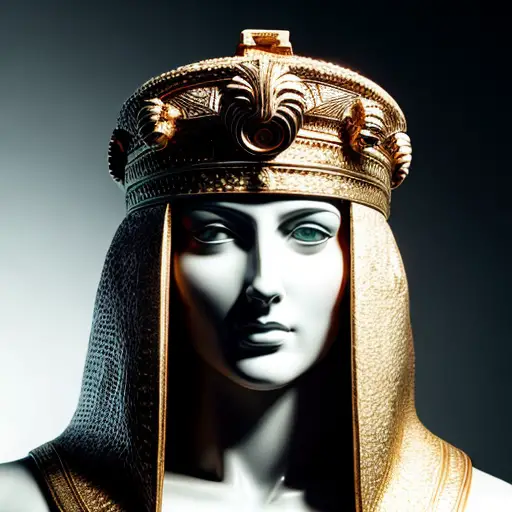Picture this: a group of four stern-looking men, standing shoulder to shoulder, their muscular bodies frozen in time. No, it's not a scene from a Roman version of 'The Avengers,' but rather the enigmatic masterpiece known as The Four Tetrarchs. This captivating Roman portrait sculpture, created during the tumultuous era of the late third century, represents the unity and power of the tetrarchy system. Each figure, with its identical features and military attire, symbolizes the shared responsibility and authority of the four emperors ruling over the vast Roman Empire. It's as if these stone warriors are saying, 'We may be carved from marble, but we're a force to be reckoned with!'
The Roman portrait sculpture, known as the Four Tetrarchs, represents a unique and fascinating period in Roman history. Created during the late 3rd century AD, the sculpture depicts four identical figures standing closely together, each with their arms around one another. What makes this artwork particularly intriguing is that it symbolizes the concept of the Tetrarchy, a system of government introduced by Emperor Diocletian to address the political instability and military threats faced by the Roman Empire at the time. The Tetrarchy divided the empire into four regions, with two senior emperors (Augusti) and two junior emperors (Caesars) ruling jointly. The sculpture captures the unity and shared power of the four rulers, emphasizing the importance of cooperation and stability in a time of crisis. Interestingly, the figures are portrayed with similar facial features and expressions, highlighting the idea of collective leadership rather than individuality. The Four Tetrarchs sculpture serves as a powerful reminder of the innovative political strategies employed by the Romans to maintain their vast empire.
Imagine a sculpture that could speak volumes without uttering a single word. Enter the enigmatic masterpiece known as The Four Tetrarchs. This captivating Roman portrait sculpture, crafted during the chaotic era of the late third century, unveils a profound message of unity and shared power. The four identical figures, standing tall and resolute, symbolize the tetrarchy system, where four emperors ruled over the vast Roman Empire. With their stoic expressions and intertwined arms, these stone warriors convey a powerful message: together, we are invincible. It's as if they are saying, 'We may be made of stone, but our strength lies in our unity.'

In the realm of Roman art, few sculptures possess the political significance and symbolic power of The Four Tetrarchs. Crafted during the tumultuous late third century, this remarkable portrait sculpture serves as a visual representation of the tetrarchy system, a unique form of governance established by Emperor Diocletian. The four identical figures, standing side by side, embody the unity and shared authority of the four emperors ruling over the vast Roman Empire. With their stern expressions and military attire, these stone guardians exude a sense of strength and stability, reminding all who gaze upon them of the empire's might.
The choice to depict the tetrarchs as identical figures is not a mere artistic decision but a deliberate political statement. By presenting the emperors as indistinguishable from one another, the sculpture emphasizes the collective nature of their rule. It conveys the idea that no single emperor holds absolute power, but rather, it is through their combined efforts that the empire can be governed effectively. This representation of unity serves as a visual reminder to both the ruling class and the general populace that a strong and stable empire can only be achieved through cooperation and shared responsibility.
Furthermore, the intertwined arms of the tetrarchs symbolize their interconnectedness and mutual support. It is as if they are bound together, forming a formidable force that can withstand any challenge. This portrayal not only reflects the political reality of the tetrarchy system but also serves as a powerful message to potential adversaries. It sends a clear signal that any attempt to disrupt the unity of the empire will be met with unwavering resistance.
The Four Tetrarchs stands as a testament to the ingenuity of Roman art and its ability to convey complex political ideas through visual representation. This sculpture serves as a constant reminder of the tetrarchy system's success in maintaining stability and order during a time of great upheaval. It encapsulates the essence of the Roman Empire, showcasing the strength that can be achieved when power is shared and unity is embraced. As guardians of the empire, the tetrarchs stand tall, their presence a constant reminder of the enduring legacy of Roman governance.
The Roman portrait sculpture, known as the Four Tetrarchs, represents a unique and fascinating aspect of Roman history. It depicts two pairs of identical figures, each pair consisting of an older and a younger man, standing closely together and embracing. However, what makes this sculpture truly intriguing is that it symbolizes the concept of the Tetrarchy, a system of government introduced by Emperor Diocletian in the late 3rd century AD. In this system, power was shared between two senior emperors (Augusti) and their junior colleagues (Caesars), with each pair ruling over different regions of the Roman Empire. The Four Tetrarchs sculpture captures the unity and harmony of this political arrangement, showcasing the idea that power can be effectively shared and balanced.
The Four Tetrarchs, a captivating Roman portrait sculpture, goes beyond its stone and bronze composition to unravel the cultural and historical context of its creation. Crafted during the late third century, this masterpiece represents the tetrarchy system, a unique form of governance established by Emperor Diocletian. Beyond its political significance, the sculpture reflects the cultural and historical climate of the time. The stern expressions and military attire of the tetrarchs embody the militaristic nature of the Roman Empire, while their identical features and intertwined arms symbolize the unity and shared responsibility necessary for the empire's survival. This sculpture serves as a tangible reminder of the complex interplay between politics, culture, and history, offering a glimpse into the fascinating world of ancient Rome.